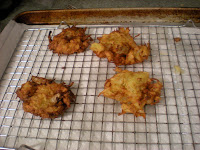Waffle time, it's waffle time, will you have some waffles of mine? Waffles are great. Really. Their uniqe shape means that the waffle has more outside than inside! And here's the waffle's real claim to fame (at least to us nerds) One day, a US man figured out that the trick to making great shoes could lie in the interesting physyology of the waffle, and poured liquid rubber into his wife's waffle iron. He named the shoes after the goddess of victory- Nike. There you have it- ridiculously overpriced shoes would never exist without our humble fluffy friend.But seriously, this common baked good has fallen from grace. It's been relegated to frozen floppy things flavored with yummy catalyzed polymeriztion! Know where I just saw that word? The side of a paint can. Here is a shiny new recipe for fluffy, yummy waffles with no polymers.
1 3/4 cup flour- 2 teaspoons baking p owder
- 1/2 teaspoon salt
- 1 tablespoon sugar
- 3 eggs
- 7 tablespoons vegetable oil
- 1 1/2 cups milk
Mix all the dry ingredients in a large bowl. Like, the second largest you have. (I say second largest because I know people whose largest bowl could be mistaken for a satellite dish. But hey, who needs all those channels when we youtube have cat videos?)
Separate the eggs, and use your electric mixer to beat the whites to stiff peaks. Like weebles, stiff peaks wobble, but they don't fall down. In a smaller bowl (not small, but smaller.), beat the yolks, and then beat in the oil and milk. Then, mix that into the dry ingredients (whisking, please!).
Now we come to the waffle dilemma: mixing the light, airy eggs into the dense, heavy batter. How to solve it? Well, you might want to call on your fourth grade teacher. Why? Fractions, my friends. Divide the eggs into thirds. Stir in the first third as quickly as possible- this step is not about folding, you just want to lighten the batter for the eggs to come. Then add the second third (second third? wow. i need better words.) and fold it in. Repeat with the last of the eggs.
At this point, your waffle iron should be heated up. You did heat the waffle iron, right? Good job. Use a spring-loaded ice cream scooper to put two scoops of batter into the iron, close, and wait. When it's done, remove with a fork and enjoy. :)







